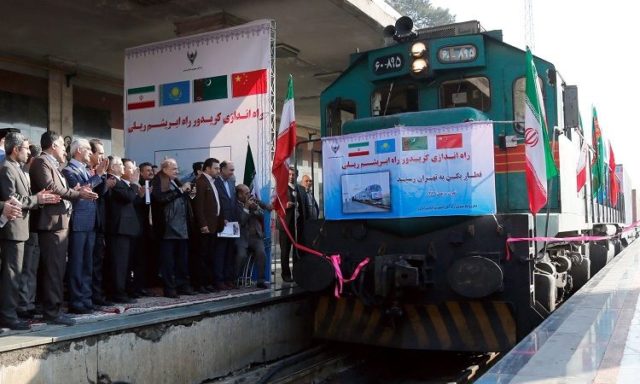
Central Asian Rail Deal Allowing China to Bypass Russia, Expand Trade with Europe
Publication: Eurasia Daily Monitor Volume: 17 Issue: 56
By:

For the last two decades, Moscow has counted on Beijing’s regular use of Russian railways to export Chinese goods to Europe. In turn, China’s reliance on Russian rail was based on the presumption that any substitute overland route via Central Asia would be hampered by the need for goods to be offloaded onto ships to cross the Caspian Sea and then reloaded on the other side. However, increasing cooperation between China, the Central Asian countries, and Iran signals that Beijing may soon be able to ship goods to and from Europe by train without the time-intensive process of having to transfer them to ships on the Caspian. In the future, China may even be able to compel Central Asian countries to adopt the international track gauge (used by both China and Europe but not countries of the former Soviet Union) or at least lay standard tracks alongside existing Russian-gauge ones—a step Moscow refuses to take itself and opposes in other post-Soviet states. Already, the current expansion in Chinese-European rail traffic is having geopolitical consequences; and the potential opening of an Iranian route in a year or two would transform them further, with China becoming the paramount power in Central Asia and Russia scrambling to retain what influence it can.
Driving present trans-continental rail developments is the radical reduction in the time it now takes for trains to move between China and Europe. In 2006, when Russia was China’s only overland option, the slow speeds on railways in the Russian Federation meant that the journey took 36 days. Now, thanks to improvements driven by competition with the Central Asian route, trains can make this trip across Russia in 16 days or even less, and prices have come down as well. However, the Central Asian route has gained in popularity even more rapidly. It is shorter still and speeds are better (see EDM, February 25, 2020). Moreover, the length of time it takes to travel and the price of moving cargo may soon fall further given the opening, at the end of last year, of a rail tunnel under the Bosporus, in Turkey (see EDM, December 2, 2019), and the projected opening of a new rail bridge later this year or next. If an Iranian route becomes available, transit times could tumble further; and if China succeeds in persuading Central Asian countries to lay international- as opposed to Russian-gauge track, they would go down even more, as would prices. All this would make the Central Asian route far more attractive to China than the corridor across Russia (Tschudi Logistics, March 20).
China’s focus on developing railways in Central Asia, of course, is driven not only by price but also by geopolitical calculations (see EDM, August 2, 2016, November 17, 2017, March 21, 2019). Both economics and politics were front and center at the end of last year, when officials from countries in the region, including Iran, agreed not only to simplify tariffs and border crossing regimes but to begin construction of two rail corridors from China to Europe. These new corridors would eliminate the need to shift cargo from railways to ships, a major breakthrough for Beijing even though it was not formally represented at the session (Chinalogist.ru, November 11, 2019).
The first of these Iranian corridors would pass from the Turkmenistani city of Serkhetyak to Iran’s Serakhs; the second from Turkmenistan’s Akyayla into northern Iran. Neither has yet been built, but such rail lines would have the effect of linking the countries of Central Asia not to the West and the United States, but to China and, to a lesser extent, to Iran. Moscow is worried that this will allow Beijing to redirect rail traffic around Russia, and the Kremlin apparently plans to play up the threat of an expanded Iranian role as a means of generating US opposition to investments in such projects (Chinalogist.ru, November 25, 2019). Indeed, some Russians are already speaking about railways leading to “a Pax Sinica” in Central Asia, something Moscow opposes but may find difficult to stop (4pera.com, March 25, 2020).
Just how much pent-up pressure there is for the expansion of rail ties between China and Europe was underscored earlier this month. Namely, despite the COVID-19 pandemic, a train from Tashkent headed west and crossed the Caspian in only a few days, thus allowing it to link up with the Baku–Tbilisi–Kars (BTK) Railroad and pass into Turkey, where it is now possible for rail traffic to move unimpeded into Europe (Railway.uz, April 6; Caspian Herald, April 23). While Uzbekistani officials did not stress China’s involvement, it was certainly there given that this inter-modal train was followed only a few weeks later by a train with Chinese cargo from Kyrgyzstan. That latter train passed through Uzbekistan and then on to Turkmenistan and Azerbaijan. Back in January, Tashkent celebrated the speed record another trans-Eurasian train set while passing through Uzbekistan (Railway.uz, January 27).
In an attempt to protect its influence in Central Asia, Moscow has been playing up anti-Chinese sentiment in the region (Ia-centr.ru, September 11, 2019; see EDM September 10, 2019) as well as promoting north-south rail development in Iran, even promising to pay most of the associated costs (see EDM, March 24, 2020). The projected value to Iran of such a north-south route is far less than the east-west one. Consequently, when the pandemic and the associated economic crisis ease, Russia is likely to see its influence in Central Asia and Iran decline even further as China expands both its rail traffic and political role in both.



